Sensitivity Analysis of Leakage Correction of GRACE Data in Southwest China Using A-Priori Model Simulations: Inter-Comparison of Spherical Harmonics, Mass Concentration and In Situ Observations
Abstract
:1. Introduction
2. Study Region and Data
2.1. Study Region
2.2. GRACE Data
2.3. Global Model Simulations
2.4. In Situ Observations
3. Methods
3.1. Estimation of Regional-Averaged GRACE TWS
3.2. Leakage Correction Methods
4. Results and Discussion
4.1. Modelled SMS versus In Situ Observations
4.2. Uncorrected GRACE TWS versus In Situ Observations
4.3. Scaling Factors Derived from Different Models
4.4. Leakage-Corrected and Mascon-Based GRACE TWS versus In Situ Observations
5. Conclusions
Supplementary Materials
Author Contributions
Funding
Acknowledgments
Conflicts of Interest
References
- Tiwari, V.M.; Wahr, J.; Swenson, S. Dwindling groundwater resources in northern India, from satellite gravity observations. Geophys. Res. Lett. 2009, 36. [Google Scholar] [CrossRef] [Green Version]
- Huang, Z.; Pan, Y.; Gong, H.; Yeh, P.J.F.; Li, X.; Zhou, D.; Zhao, W. Subregional-scale groundwater depletion detected by GRACE for both shallow and deep aquifers in North China Plain. Geophys. Res. Lett. 2015, 42, 1791–1799. [Google Scholar] [CrossRef]
- Gong, H.; Pan, Y.; Zheng, L.; Li, X.; Zhu, L.; Zhang, C.; Huang, Z.; Li, Z.; Wang, H.; Zhou, C. Long-term groundwater storage changes and land subsidence development in the North China Plain (1971–2015). Hydrogeol. J. 2018, 26, 1417–1427. [Google Scholar] [CrossRef]
- Velicogna, I.; Sutterley, T.C.; van den Broeke, M.R. Regional acceleration in ice mass loss from Greenland and Antarctica using GRACE time-variable gravity data. Geophys. Res. Lett. 2014, 41, 8130–8137. [Google Scholar] [CrossRef] [Green Version]
- Seo, K.; Wilson, C.R.; Scambos, T.; Kim, B.; Waliser, D.E.; Tian, B.; Kim, B.; Eom, J. Surface mass balance contributions to acceleration of Antarctic ice mass loss during 2003–2013. J. Geophys. Res. Solid Earth 2015, 120, 3617–3627. [Google Scholar] [CrossRef] [PubMed]
- Riegger, J. Quantification of Drainable Water Storage Volumes in Catchments and in River Networks on Global Scales using the GRACE and/or River Runoff. Hydrol. Earth Syst. Sci. 2018. [Google Scholar] [CrossRef]
- Tourian, M.J.; Reager, J.T.; Sneeuw, N. The total drainable water storage of the Amazon River Basin: A first estimate using GRACE. Water Resour. Res. 2018, 54, 3290–3312. [Google Scholar] [CrossRef]
- Pan, Y.; Zhang, C.; Gong, H.; Yeh, P.J.F.; Shen, Y.; Guo, Y.; Huang, Z.; Li, X. Detection of human-induced evapotranspiration using GRACE satellite observations in the Haihe River basin of China. Geophys. Res. Lett. 2017, 44, 190–199. [Google Scholar] [CrossRef]
- Ramillien, G.; Frappart, F.; Güntner, A.; Ngo-Duc, T.; Cazenave, A.; Laval, K. Time variations of the regional evapotranspiration rate from Gravity Recovery and Climate Experiment (GRACE) satellite gravimetry. Water Resour. Res. 2006, 42. [Google Scholar] [CrossRef] [Green Version]
- Syed, T.H.; Famiglietti, J.S.; Chambers, D.P. GRACE-Based Estimates of Terrestrial Freshwater Discharge from Basin to Continental Scales. J. Hydrometeorol. 2009, 10, 22–40. [Google Scholar] [CrossRef]
- Thomas, A.C.; Reager, J.T.; Famiglietti, J.S.; Rodell, M. A GRACE-based water storage deficit approach for hydrological drought characterization. Geophys. Res. Lett. 2014, 41, 1537–1545. [Google Scholar] [CrossRef] [Green Version]
- Long, D.; Shen, Y.; Sun, A.; Hong, Y.; Longuevergne, L.; Yang, Y.; Li, B.; Chen, L. Drought and flood monitoring for a large karst plateau in Southwest China using extended GRACE data. Remote Sens. Environ. 2014, 155, 145–160. [Google Scholar] [CrossRef]
- Forman, B.A.; Reichle, R.H.; Rodell, M. Assimilation of terrestrial water storage from GRACE in a snow-dominated basin. Water Resour. Res. 2012, 48. [Google Scholar] [CrossRef]
- Girotto, M.; De Lannoy, G.J.M.; Reichle, R.H.; Rodell, M. Assimilation of gridded terrestrial water storage observations from GRACE into a land surface model. Water Resour. Res. 2016, 52, 4164–4183. [Google Scholar] [CrossRef] [Green Version]
- Vishwakarma, B.D.; Devaraju, B.; Sneeuw, N. Minimizing the effects of filtering on catchment scale GRACE solutions. Water Resour. Res. 2016, 52, 5868–5890. [Google Scholar] [CrossRef] [Green Version]
- Watkins, M.M.; Wiese, D.N.; Yuan, D.; Boening, C.; Landerer, F.W. Improved methods for observing Earth’s time variable mass distribution with GRACE using spherical cap mascons. J. Geophys. Res. Solid Earth 2015, 120, 2648–2671. [Google Scholar] [CrossRef]
- Bettadpur, S. Insights into the Earth System mass variability from CSR-RL05 GRACE gravity fields. In Proceedings of the EGU General Assembly 2012, Vienna, Austria, 22–27 April 2012; p. 6409. [Google Scholar]
- Wahr, J.; Molenaar, M.; Bryan, F. Time variability of the Earth’s gravity field: Hydrological and oceanic effects and their possible detection using GRACE. J. Geophys. Res. Solid Earth 1998, 103, 30205–30229. [Google Scholar] [CrossRef]
- Mu, D.; Yan, H.; Feng, W.; Peng, P. GRACE leakage error correction with regularization technique: Case studies in Greenland and Antarctica. Geophys. J. Int. 2017, 208, 1775–1786. [Google Scholar] [CrossRef]
- Longuevergne, L.; Scanlon, B.R.; Wilson, C.R. GRACE Hydrological estimates for small basins: Evaluating processing approaches on the High Plains Aquifer, USA. Water Resour. Res. 2010, 46. [Google Scholar] [CrossRef]
- Chen, X.; Long, D.; Hong, Y.; Zeng, C.; Yan, D. Improved modeling of snow and glacier melting by a progressive two-stage calibration strategy with GRACE and multisource data: How snow and glacier meltwater contributes to the runoff of the Upper Brahmaputra River basin? Water Resour. Res. 2017, 53, 2431–2466. [Google Scholar] [CrossRef]
- Velicogna, I.; Wahr, J. Measurements of Time-Variable Gravity Show Mass Loss in Antarctica. Science 2006, 311, 1754–1756. [Google Scholar] [CrossRef] [PubMed] [Green Version]
- Scanlon, B.R.; Longuevergne, L.; Long, D. Ground referencing GRACE satellite estimates of groundwater storage changes in the California Central Valley, USA. Water Resour. Res. 2012, 48. [Google Scholar] [CrossRef] [Green Version]
- Famiglietti, J.S.; Lo, M.; Ho, S.L.; Bethune, J.; Anderson, K.J.; Syed, T.H.; Swenson, S.C.; de Linage, C.R.; Rodell, M. Satellites measure recent rates of groundwater depletion in California’s Central Valley. Geophys. Res. Lett. 2011, 38. [Google Scholar] [CrossRef]
- Long, D.; Yang, Y.; Wada, Y.; Hong, Y.; Liang, W.; Chen, Y.; Yong, B.; Hou, A.; Wei, J.; Chen, L. Deriving scaling factors using a global hydrological model to restore GRACE total water storage changes for China’s Yangtze River Basin. Remote Sens. Environ. 2015, 168, 177–193. [Google Scholar] [CrossRef]
- Chen, J.L.; Wilson, C.R.; Li, J.; Zhang, Z. Reducing leakage error in GRACE-observed long-term ice mass change: A case study in West Antarctica. J. Geod. 2015, 89, 925–940. [Google Scholar] [CrossRef]
- Chen, J.; Li, J.; Zhang, Z.; Ni, S. Long-term groundwater variations in Northwest India from satellite gravity measurements. Glob. Planet. Chang. 2014, 116, 130–138. [Google Scholar] [CrossRef] [Green Version]
- Vishwakarma, B.D.; Horwath, M.; Devaraju, B.; Groh, A.; Sneeuw, N. A Data-Driven Approach for Repairing the Hydrological Catchment Signal Damage Due to Filtering of GRACE Products. Water Resour. Res. 2017, 53, 9824–9844. [Google Scholar] [CrossRef]
- Khaki, M.; Forootan, E.; Kuhn, M.; Awange, J.; Longuevergne, L.; Wada, Y. Efficient basin scale filtering of GRACE satellite products. Remote Sens. Environ. 2018, 204, 76–93. [Google Scholar] [CrossRef] [Green Version]
- Save, H.; Bettadpur, S.; Tapley, B.D. High-resolution CSR GRACE RL05 mascons. J. Geophys. Res. Solid Earth 2016, 121, 7547–7569. [Google Scholar] [CrossRef]
- Wiese, D.N.; Landerer, F.W.; Watkins, M.M. Quantifying and reducing leakage errors in the JPL RL05M GRACE Mascon solution. Water Resour. Res. 2016, 52, 7490–7502. [Google Scholar] [CrossRef]
- Luthcke, S.B.; Sabaka, T.J.; Loomis, B.D.; Arendt, A.A.; McCarthy, J.J.; Camp, J. Antarctica, Greenland and Gulf of Alaska land-ice evolution from an iterated GRACE global mascon solution. J. Glaciol. 2013, 59, 613–631. [Google Scholar] [CrossRef]
- Zhang, L.; Yi, S.; Wang, Q.; Chang, L.; Tang, H.; Sun, W. Evaluation of GRACE mascon solutions for small spatial scales and localized mass sources. Geophys. J. Int. 2019, 218, 1307–1321. [Google Scholar] [CrossRef]
- Vishwakarma, B.D.; Devaraju, B.; Sneeuw, N. What Is the Spatial Resolution of GRACE Satellite Products for Hydrology. Remote Sens. 2018, 10, 852. [Google Scholar] [CrossRef]
- Swenson, S.; Wahr, J. Multi-sensor analysis of water storage variations of the Caspian Sea. Geophys. Res. Lett. 2007, 34. [Google Scholar] [CrossRef] [Green Version]
- Long, D.; Scanlon, B.R.; Longuevergne, L.; Sun, A.Y.; Fernando, D.N.; Save, H. GRACE satellite monitoring of large depletion in water storage in response to the 2011 drought in Texas. Geophys. Res. Lett. 2013, 40, 3395–3401. [Google Scholar] [CrossRef] [Green Version]
- Long, D.; Longuevergne, L.; Scanlon, B.R. Global analysis of approaches for deriving total water storage changes from GRACE satellites. Water Resour. Res. 2015, 51, 2574–2594. [Google Scholar] [CrossRef] [Green Version]
- Cheng, M.; Tapley, B.D. Variations in the Earth’s oblateness during the past 28 years. J. Geophys. Res. 2004, 109. [Google Scholar] [CrossRef]
- Chambers, D.P. Evaluation of new GRACE time-variable gravity data over the ocean. Geophys. Res. Lett. 2006, 33. [Google Scholar] [CrossRef]
- Chen, J.L.; Wilson, C.R.; Tapley, B.D.; Blankenship, D.D.; Ivins, E.R. Patagonia Icefield melting observed by Gravity Recovery and Climate Experiment (GRACE). Geophys. Res. Lett. 2007, 34. [Google Scholar] [CrossRef]
- Jekeli, C. Alternative Methods to Smooth the Earth’s Gravity Field; Department of Geodetic Science and Surveying, Ohio State University: Columbus, OH, USA, 1981. [Google Scholar]
- Rodell, M.; Houser, P.R.; Jambor, U.; Gottschalck, J.; Mitchell, K.; Meng, C.J.; Arsenault, K.; Cosgrove, B.; Radakovich, J.; Bosilovich, M.; et al. The global land data assimilation system. Am. Meteorol. Soc. 2004, 85, 381–394. [Google Scholar] [CrossRef]
- Döll, P.; Kaspar, F.; Lehner, B. A global hydrological model for deriving water availability indicators: Model tuning and validation. J. Hydrol. 2003, 270, 105–134. [Google Scholar] [CrossRef]
- Lehner, B.; Döll, P. Development and validation of a global database of lakes, reservoirs and wetlands. J. Hydrol. 2004, 296, 1–22. [Google Scholar] [CrossRef]
- Döll, P.; Fiedler, K.; Zhang, J. Global-scale analysis of river flow alterations due to water withdrawals and reservoirs. Hydrol. Earth Syst. Sci. 2009, 13, 2413–2432. [Google Scholar] [CrossRef] [Green Version]
- Huang, Z.; Yeh, P.J.F.; Pan, Y.; Jiao, J.J.; Gong, H.; Li, X.; Güntner, A.; Zhu, Y.; Zhang, C.; Zheng, L. Detection of large-scale groundwater storage variability over the karstic regions in Southwest China. J. Hydrol. 2019, 569, 409–422. [Google Scholar] [CrossRef]
- CIGEM. Groundwater-Level Yearbook for China Geo-Environment Monitoring; China Land Press: Beijing, China, 2005. [Google Scholar]
- Yeh, P.J.F.; Swenson, S.C.; Famiglietti, J.S.; Rodell, M. Remote sensing of groundwater storage changes in Illinois using the Gravity Recovery and Climate Experiment (GRACE). Water Resour. Res. 2006, 42. [Google Scholar] [CrossRef]
- Luo, Z.; Yao, C.; Li, Q.; Huang, Z. Terrestrial water storage changes over the Pearl River Basin from GRACE and connections with Pacific climate variability. Geod. Geodyn. 2016, 7, 171–179. [Google Scholar] [CrossRef] [Green Version]
- Yan, C.; Zhou, B.; Lu, L.; Sun, X.; Wen, X. Focal mechanisms of moderate and small earthquakes occurred after reservoir recharge in the Longtan reservoir region. Chin. J. Geophys. 2015, 58, 4207–4222. (In Chinese) [Google Scholar]
- Ministry of Water Resources (MWR). Water Regime Annual Report of Pearl River; Pearl River Water Resources Commision of the MWR: Guangzhou, Guangdong, China, 2008. (In Chinese)
- Chen, J.L.; Wilson, C.R.; Tapley, B.D.; Scanlon, B.; Güntner, A. Long-term groundwater storage change in Victoria, Australia from satellite gravity and in situ observations. Glob. Planet. Chang. 2016, 139, 56–65. [Google Scholar] [CrossRef] [Green Version]
- Swenson, S.; Wahr, J. Methods for inferring regional surface-mass anomalies from Gravity Recovery and Climate Experiment (GRACE) measurements of time-variable gravity. J. Geophys. Res. Solid Earth 2002, 107, ETG 3-1–ETG 3-13. [Google Scholar] [CrossRef]
- Klees, R.; Zapreeva, E.A.; Winsemius, H.C.; Savenije, H.H.G. The bias in GRACE estimates of continental water storage variations. Hydrol. Earth Syst. Sci. 2007, 11, 1227–1241. [Google Scholar] [CrossRef] [Green Version]
- Yang, T.; Wang, C.; Yu, Z.; Xu, F. Characterization of spatio-temporal patterns for various GRACE- and GLDAS-born estimates for changes of global terrestrial water storage. Glob. Planet. Chang. 2013, 109, 30–37. [Google Scholar] [CrossRef]
- Koster, R.D.; Suarez, M.J. Technical Report Series on Global Modeling and Data Assimilation. In Energy and Water Balance Calculations in the Mosaic LSM; Suarez, M.J., Suarez, M.J., Eds.; Goddard Space Flight Center: Greenbelt, MD, USA, 1996; Volume 9. [Google Scholar]
- Ferreira, V.G.; Montecino, H.D.C.; Yakubu, C.I.; Heck, B. Uncertainties of the Gravity Recovery and Climate Experiment time-variable gravity-field solutions based on three-cornered hat method. J. Appl. Remote Sens. 2016, 10, 015015. [Google Scholar] [CrossRef]

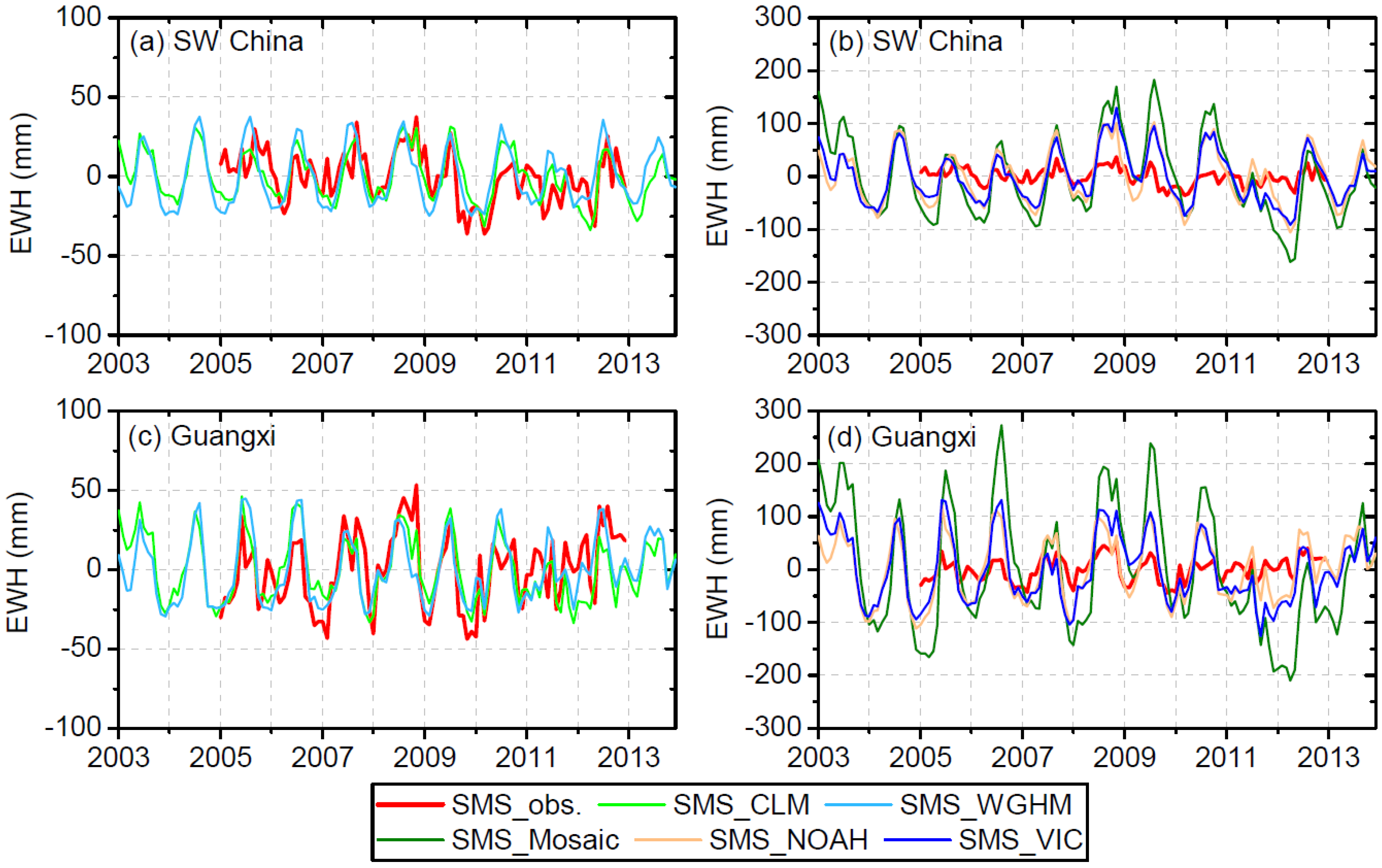
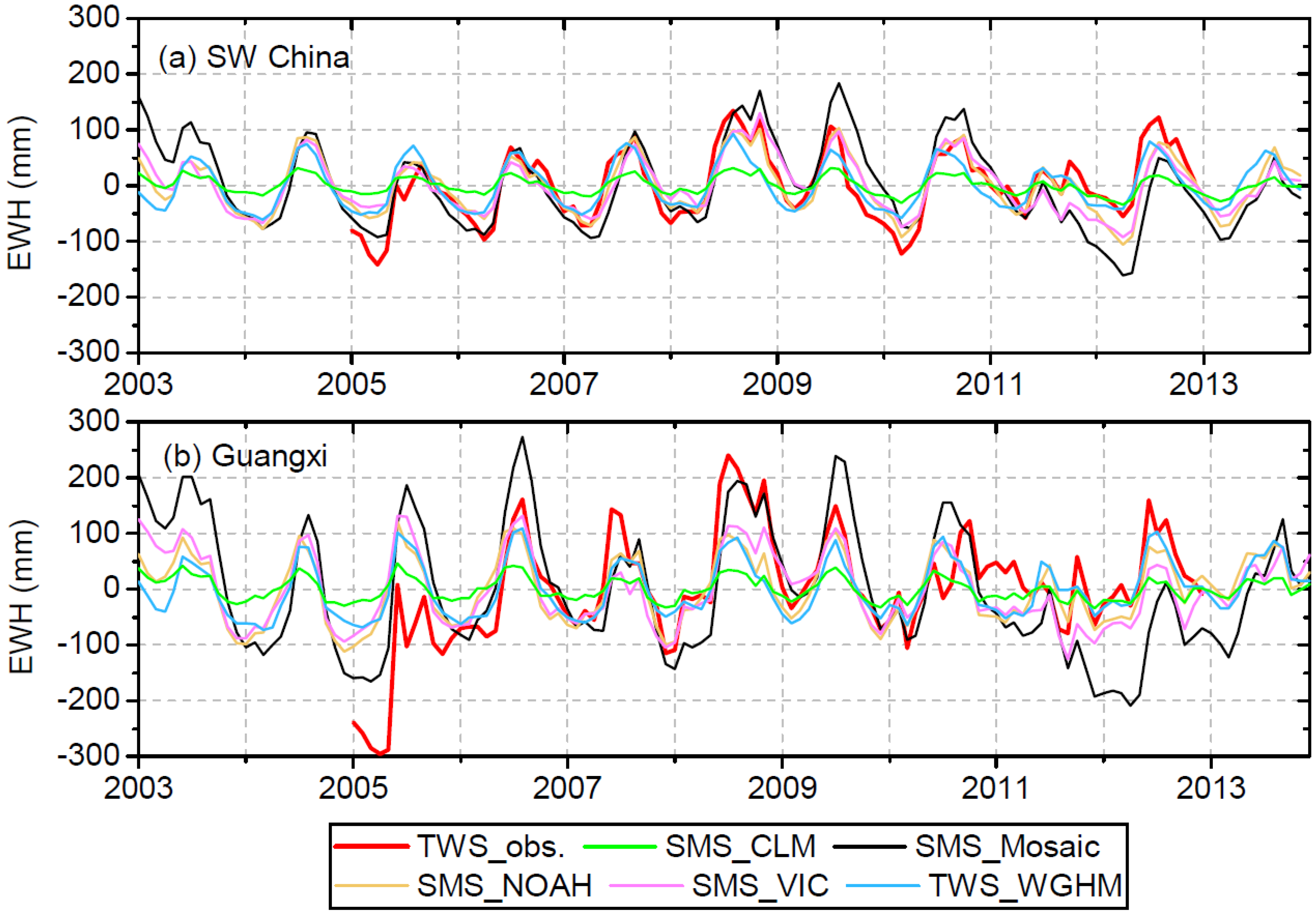

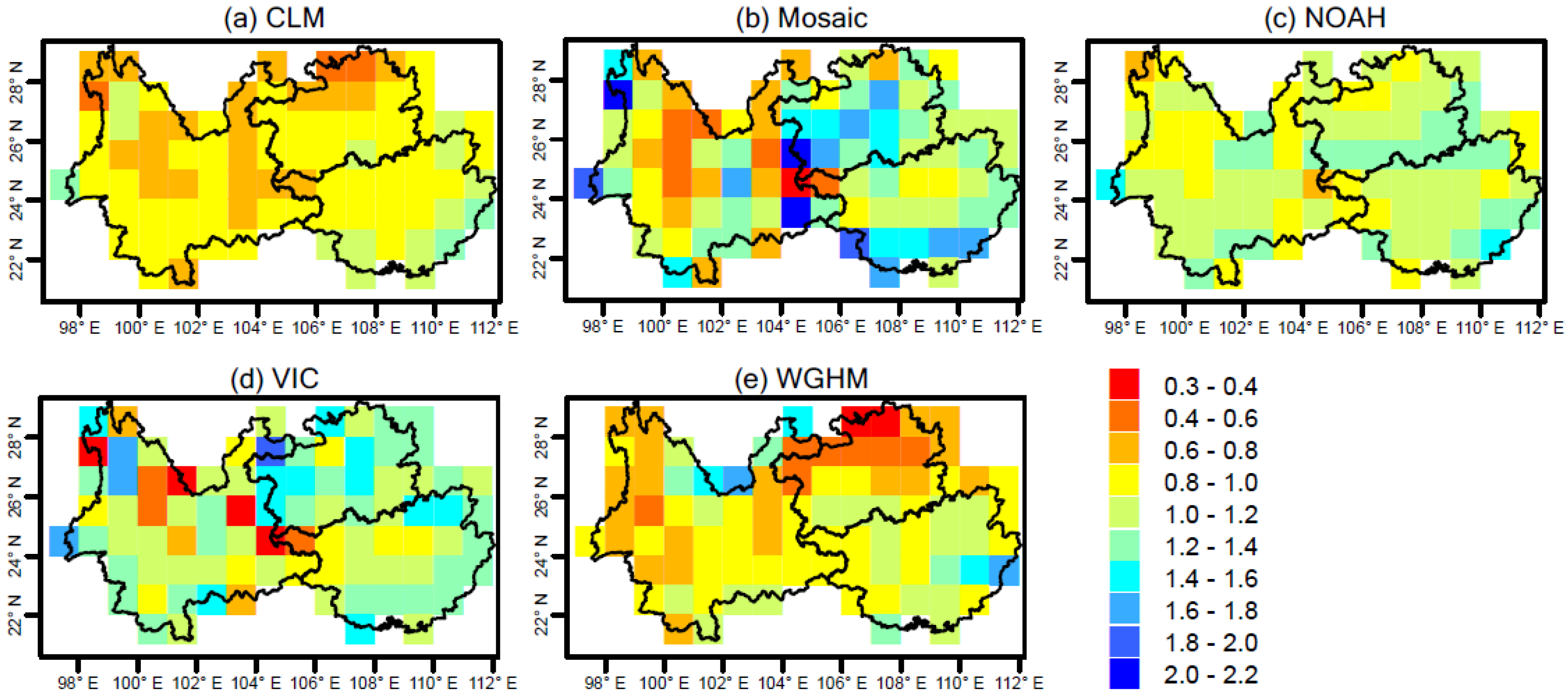
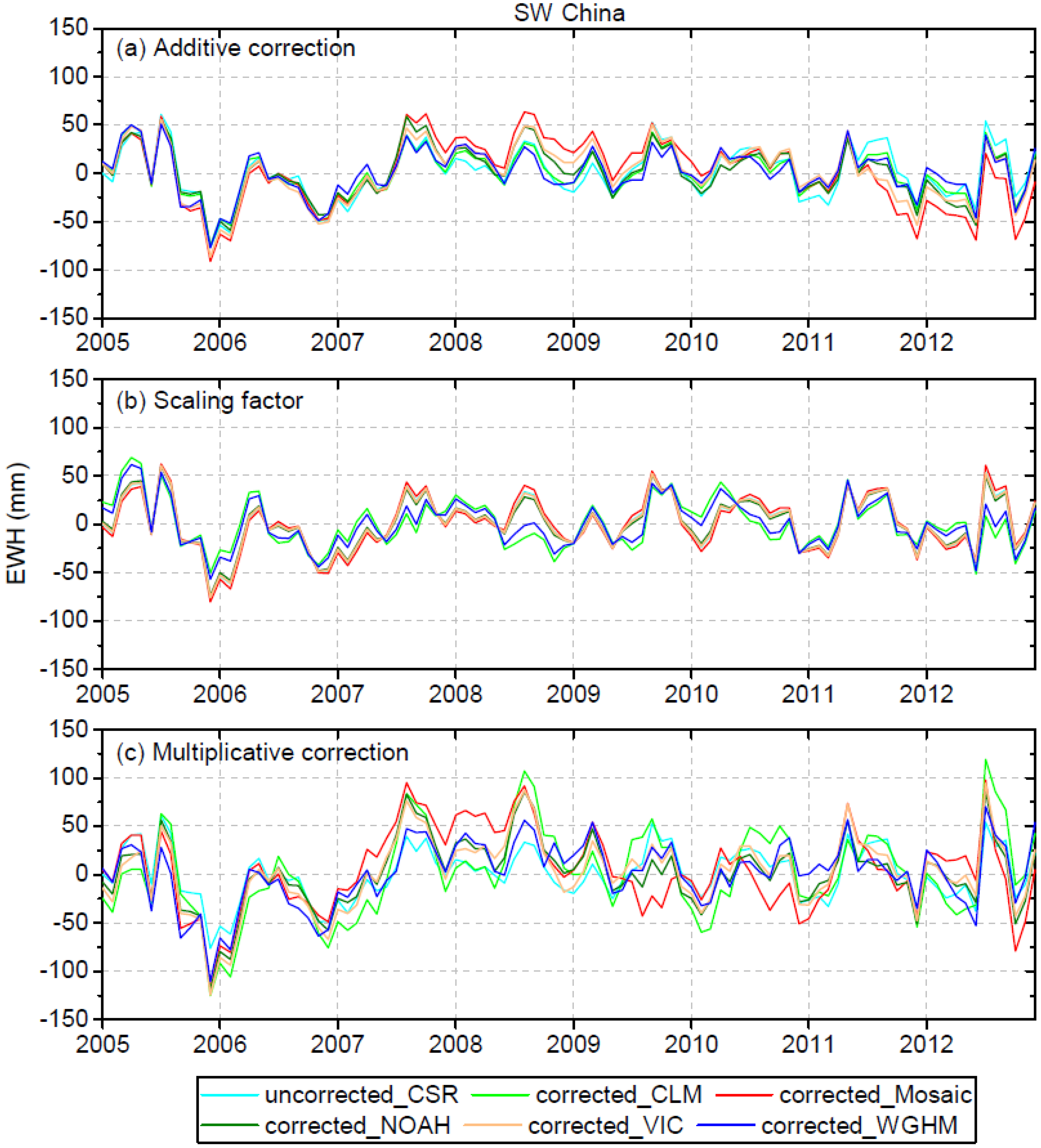
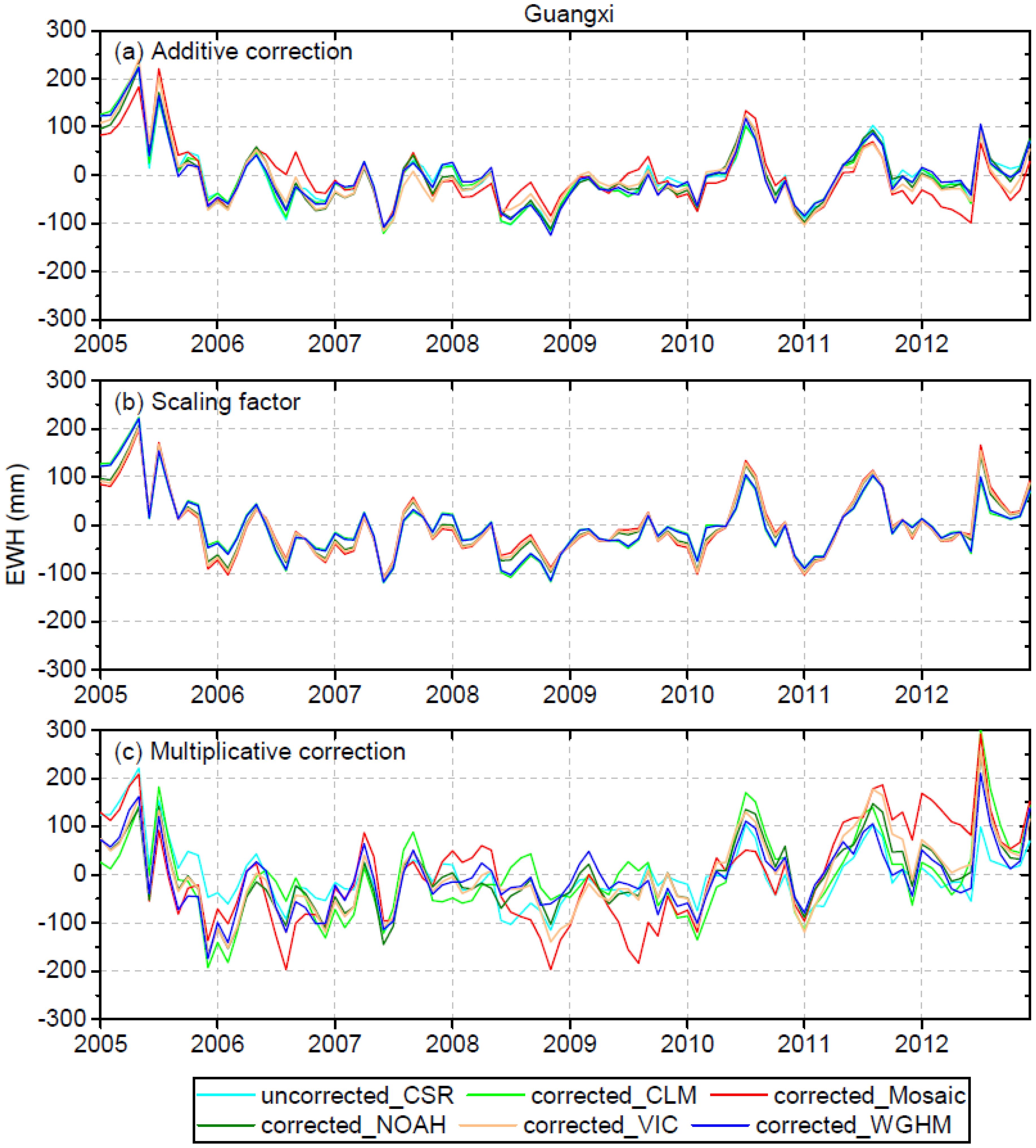
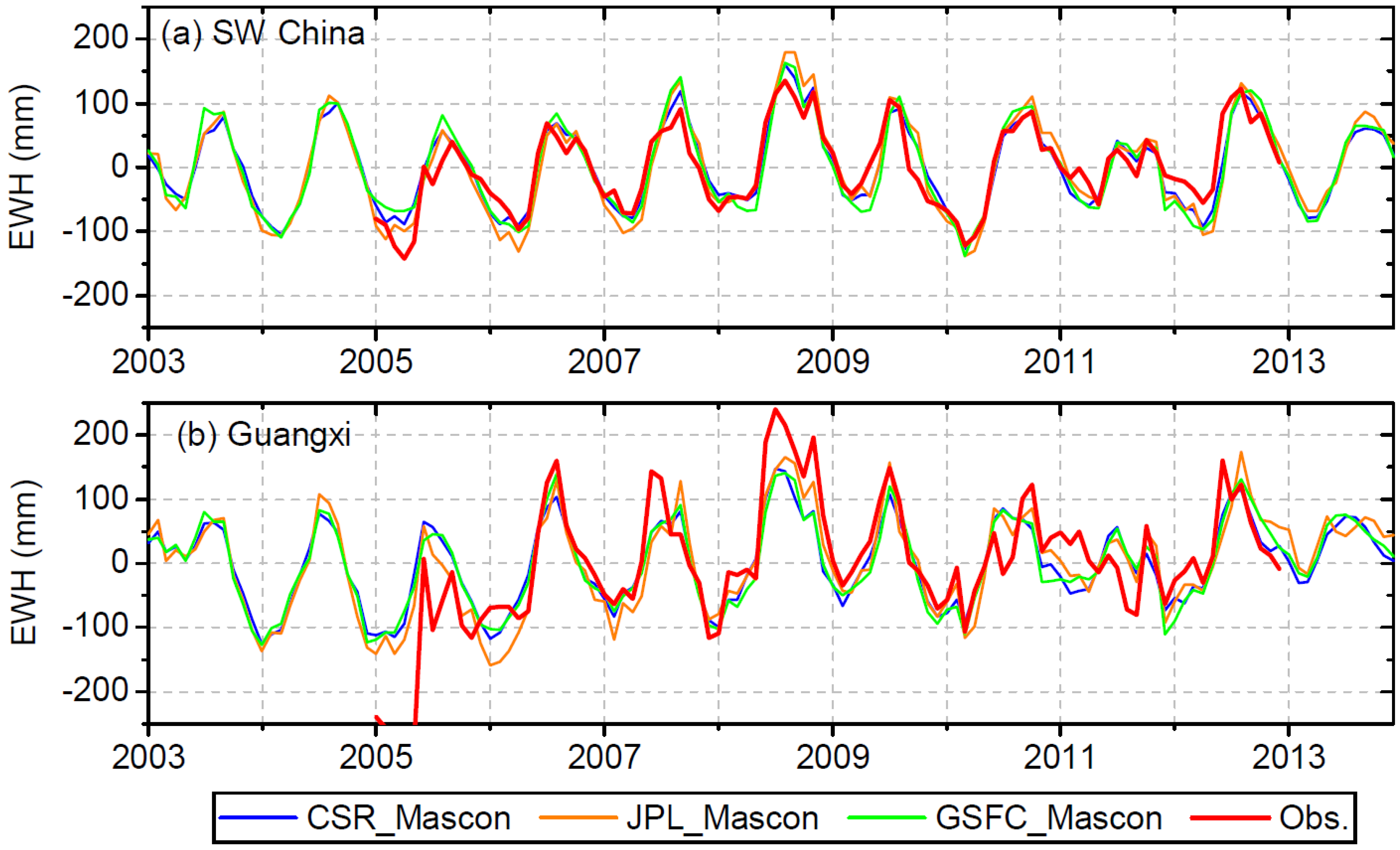
| Water Storage | Model | In Situ SMS in SW China | In Situ SMS in Guangxi | ||
| r | RMSE (mm) | r | RMSE (mm) | ||
| SMS | CLM | 0.63 | 13.5 | 0.64 | 18.5 |
| SMS | Mosaic | 0.43 | 71.0 | 0.38 | 108.2 |
| SMS | Noah | 0.59 | 44.1 | 0.70 | 45.4 |
| SMS | VIC | 0.58 | 42.2 | 0.55 | 54.3 |
| SMS | WGHM | 0.46 | 17.6 | 0.61 | 19.4 |
| Water Storage | Model/GRACE | In Situ TWS in SW China | In Situ TWS in Guangxi | ||
| r | RMSE (mm) | r | RMSE (mm) | ||
| SMS | CLM | 0.84 | 50.3 | 0.59 | 91.1 |
| SMS | Mosaic | 0.71 | 54.4 | 0.61 | 97.0 |
| SMS | Noah | 0.87 | 30.8 | 0.66 | 76.7 |
| SMS | VIC | 0.79 | 38.9 | 0.59 | 82.0 |
| TWS | WGHM | 0.86 | 34.8 | 0.64 | 79.1 |
| TWS_uncorrected | GRACE CSR | 0.93 | 27.0 | 0.79 | 63.1 |
| TWS_uncorrected | GRACE JPL | 0.93 | 29.7 | 0.80 | 61.7 |
| TWS_uncorrected | GRACE GFZ | 0.86 | 37.2 | 0.71 | 71.1 |
| Region | Scaling Factor | CLM | Mosaic | Noah | VIC | WGHM | CV |
|---|---|---|---|---|---|---|---|
| SW China | regionally integrated | 0.72 | 1.04 | 0.97 | 0.99 | 0.79 | 0.15 |
| SW China | spatially averaged | 0.88 | 1.13 | 1.09 | 1.14 | 0.92 | 0.12 |
| Relative difference | 22% | 9% | 12% | 15% | 16% | - | |
| Guangxi | regionally integrated | 0.97 | 1.34 | 1.23 | 1.28 | 1.01 | 0.14 |
| Guangxi | spatially averaged | 0.99 | 1.21 | 1.12 | 1.17 | 1.06 | 0.08 |
| Relative difference | 2% | 10% | 9% | 9% | 5% | - |
| TWS Anomalies | Model/GRACE | SW China | Guangxi | ||||
|---|---|---|---|---|---|---|---|
| r | RMSE (mm) | NSE | r | RMSE (mm) | NSE | ||
| Uncorrected | CSR | 0.93 | 27.0 | 0.82 | 0.79 | 63.1 | 0.61 |
| Additive | CLM | 0.93 | 25.0 | 0.84 | 0.79 | 63.0 | 0.61 |
| Mosaic | 0.89 | 34.2 | 0.70 | 0.80 | 60.9 | 0.64 | |
| Noah | 0.93 | 26.7 | 0.82 | 0.78 | 63.1 | 0.61 | |
| VIC | 0.91 | 29.4 | 0.78 | 0.78 | 64.1 | 0.60 | |
| WGHM | 0.93 | 24.3 | 0.85 | 0.79 | 62.6 | 0.62 | |
| Scaling Factor | CLM | 0.93 | 24.8 | 0.84 | 0.79 | 63.5 | 0.61 |
| Mosaic | 0.93 | 28.5 | 0.79 | 0.79 | 64.4 | 0.60 | |
| Noah | 0.93 | 26.0 | 0.83 | 0.79 | 63.0 | 0.61 | |
| VIC | 0.93 | 26.8 | 0.82 | 0.79 | 63.5 | 0.61 | |
| WGHM | 0.93 | 23.8 | 0.86 | 0.79 | 63.1 | 0.61 | |
| Multiplicative factor | CLM | 0.92 | 44.9 | 0.49 | 0.78 | 82.6 | 0.34 |
| Mosaic | 0.84 | 41.5 | 0.56 | 0.54 | 100.3 | 0.02 | |
| Noah | 0.91 | 35.4 | 0.68 | 0.76 | 73.4 | 0.48 | |
| VIC | 0.90 | 37.2 | 0.65 | 0.73 | 79.2 | 0.39 | |
| WGHM | 0.90 | 32.9 | 0.73 | 0.79 | 66.9 | 0.57 | |
| Mascon | CSR | 0.92 | 25.8 | 0.83 | 0.78 | 64.9 | 0.59 |
| JPL | 0.92 | 31.5 | 0.75 | 0.82 | 58.3 | 0.67 | |
| GSFC | 0.89 | 32.9 | 0.73 | 0.77 | 65.4 | 0.58 | |
© 2019 by the authors. Licensee MDPI, Basel, Switzerland. This article is an open access article distributed under the terms and conditions of the Creative Commons Attribution (CC BY) license (http://creativecommons.org/licenses/by/4.0/).
Share and Cite
Huang, Z.; Jiao, J.J.; Luo, X.; Pan, Y.; Zhang, C. Sensitivity Analysis of Leakage Correction of GRACE Data in Southwest China Using A-Priori Model Simulations: Inter-Comparison of Spherical Harmonics, Mass Concentration and In Situ Observations. Sensors 2019, 19, 3149. https://doi.org/10.3390/s19143149
Huang Z, Jiao JJ, Luo X, Pan Y, Zhang C. Sensitivity Analysis of Leakage Correction of GRACE Data in Southwest China Using A-Priori Model Simulations: Inter-Comparison of Spherical Harmonics, Mass Concentration and In Situ Observations. Sensors. 2019; 19(14):3149. https://doi.org/10.3390/s19143149
Chicago/Turabian StyleHuang, Zhiyong, Jiu Jimmy Jiao, Xin Luo, Yun Pan, and Chong Zhang. 2019. "Sensitivity Analysis of Leakage Correction of GRACE Data in Southwest China Using A-Priori Model Simulations: Inter-Comparison of Spherical Harmonics, Mass Concentration and In Situ Observations" Sensors 19, no. 14: 3149. https://doi.org/10.3390/s19143149






